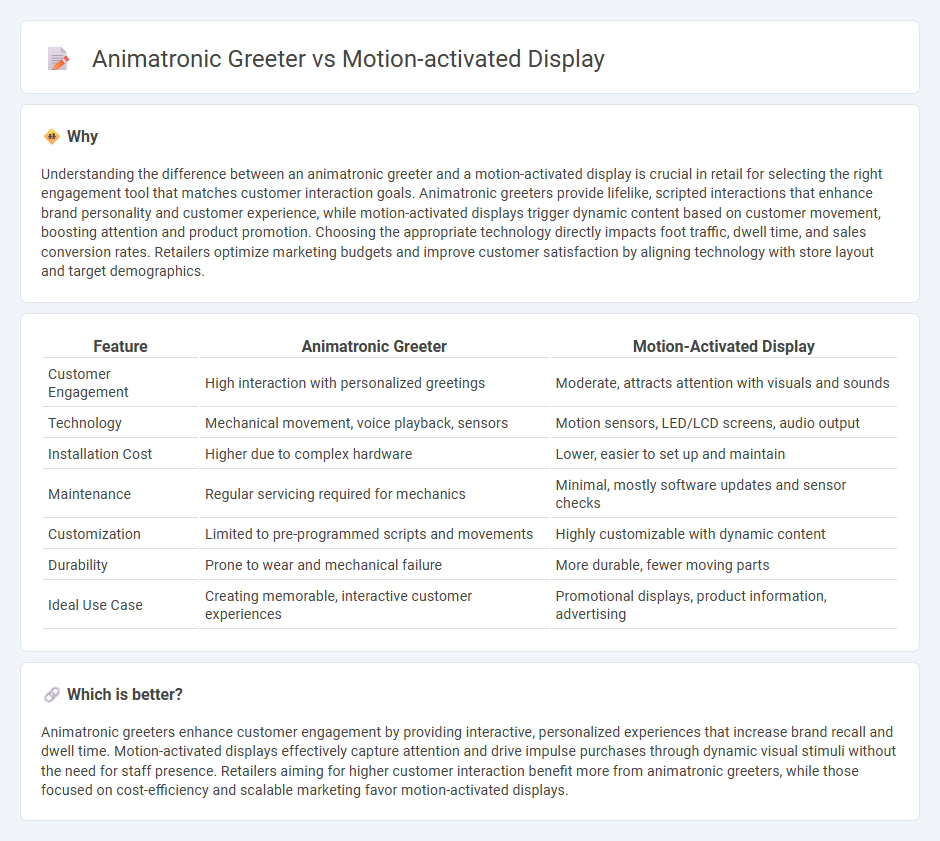
Animatronic greeters create a memorable in-store experience by offering interactive, lifelike welcomes that engage customers visually and emotionally, enhancing brand presence. Motion-activated displays attract attention through dynamic content triggered by customer movement, efficiently showcasing promotions and product information. Explore how these technologies can transform retail environments and boost customer engagement.
Why it is important
Understanding the difference between an animatronic greeter and a motion-activated display is crucial in retail for selecting the right engagement tool that matches customer interaction goals. Animatronic greeters provide lifelike, scripted interactions that enhance brand personality and customer experience, while motion-activated displays trigger dynamic content based on customer movement, boosting attention and product promotion. Choosing the appropriate technology directly impacts foot traffic, dwell time, and sales conversion rates. Retailers optimize marketing budgets and improve customer satisfaction by aligning technology with store layout and target demographics.
Comparison Table
| Feature | Animatronic Greeter | Motion-Activated Display |
|---|---|---|
| Customer Engagement | High interaction with personalized greetings | Moderate, attracts attention with visuals and sounds |
| Technology | Mechanical movement, voice playback, sensors | Motion sensors, LED/LCD screens, audio output |
| Installation Cost | Higher due to complex hardware | Lower, easier to set up and maintain |
| Maintenance | Regular servicing required for mechanics | Minimal, mostly software updates and sensor checks |
| Customization | Limited to pre-programmed scripts and movements | Highly customizable with dynamic content |
| Durability | Prone to wear and mechanical failure | More durable, fewer moving parts |
| Ideal Use Case | Creating memorable, interactive customer experiences | Promotional displays, product information, advertising |
Which is better?
Animatronic greeters enhance customer engagement by providing interactive, personalized experiences that increase brand recall and dwell time. Motion-activated displays effectively capture attention and drive impulse purchases through dynamic visual stimuli without the need for staff presence. Retailers aiming for higher customer interaction benefit more from animatronic greeters, while those focused on cost-efficiency and scalable marketing favor motion-activated displays.
Connection
Animatronic greeters enhance customer engagement by providing personalized, lifelike interactions at store entrances, while motion-activated displays capture shopper attention by responding dynamically to movement. Both technologies leverage sensor-driven automation to create immersive retail experiences that increase dwell time and encourage product exploration. Integrating these innovations can boost foot traffic and sales by delivering interactive, memorable brand interactions within retail environments.
Key Terms
Customer Engagement
Motion-activated displays capture customer attention by triggering dynamic visuals or sounds when movement is detected, creating an interactive experience that encourages exploration and product discovery. Animatronic greeters provide a lifelike, personable interaction by combining robotics and AI to simulate human gestures and speech, fostering an emotional connection and enhancing brand memorability. Explore the impact of these technologies on customer engagement to determine the most effective solution for your business.
Interactive Technology
Motion-activated displays use sensors to detect movement and trigger visual or auditory responses, creating dynamic user engagement with minimal human intervention. Animatronic greeters combine robotics, mechanical movements, and programming to simulate lifelike gestures and speech, offering a highly immersive and personalized interactive experience. Explore our detailed comparison to understand which technology best suits your interactive marketing needs.
Visual Merchandising
Motion-activated displays use sensors to trigger dynamic content, enhancing customer engagement through interactive visual merchandising techniques. Animatronic greeters offer lifelike movements and realistic appearances, creating memorable in-store experiences that boost brand recognition. Explore these innovative visual merchandising tools to elevate your retail environment and captivate shoppers effectively.
Source and External Links
Exciting Ways to Use Motion Sensors with Digital Signage - OnSign TV - Motion-activated displays use sensors to trigger specific content when a person approaches, enabling interactive, personalized, and dynamic presentations such as product demos, gamification, and changing content based on proximity.
Motion Sensor Activated Commercial LCD Advertising Display - Commercial LCD displays with motion sensors activate media playback (images, videos) when body movement is detected, ideal for in-store advertising with programmable settings like standby times and detection distance up to 3 meters.
Digital Signage Motion Sensors - Saturn Visual Solutions - Motion sensor digital signage enhances engagement by showing personalized content triggered by user proximity, saving energy by playing content only when needed, and enabling interactive control and customer journey automation in retail and leisure spaces.
 dowidth.com
dowidth.com